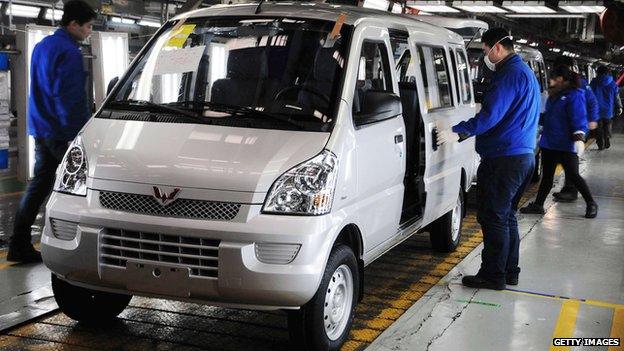China's no-win situation
- Published

China sold more than 20 million vehicles in 2013, despite a slowing economy
China exceeded its 2013 growth target of 7.5% as today's figures showed GDP expansion of 7.7%.
Yet stocks across Asia fell and analysts are gloomy, estimating that this coming year will see the slowest growth since 1990 of 7.4%.
Growth is already much slower than the prior decade, since 7.7% growth, the same as in 2012, is the weakest since 1999 - that's the aftermath of the Asian financial crisis.
If the forecasts are right, then 7.4% growth would be the slowest since 1990, which is before China significantly opened its economy to the world.
But the Chinese government is attempting to persuade markets and others that it is slowing the economy down to a more sustainable pace and trying to be less reliant on investment-led, credit-fuelled growth.
Notably, fixed asset investment expanded 19.6% last year, which is about the slowest pace in a decade. Industrial production growth has also slowed to less than 10% year-on-year, less than half the 22% annual average expansion during the 2000s.
Rebalancing
This is the core of the concern. China is aiming to restructure its growth drivers away from investment and production towards consumption and services. Such economies grow more slowly than those in the process of industrialisation. With industry having accounted for half of GDP, China is past the rapid, catch-up phase.
In this next era it is tougher to sustain a healthy growth rate. Many countries, as they de-industrialise and move more into services, see a deceleration in growth.
The premier Li Keqiang views 7% as the lowest acceptable growth rate. But there are numerous challenges achieving it, which I have written about before.
There's one that looms large. China's working-age population fell by 2.44 million last year, which is the second straight year of decline. It is reminiscent of the problems of ageing faced by rather more developed countries like Japan.
A shrinking workforce usually means less investment and productivity; China's problem is self-inflicted through its one-child policy.
The government has decided to relax the policy and allow parents who are single children themselves to have more than one child. It will take a generation before the change bears fruit, however.
Shrinking
For now, China has the challenge of trying to raise the productivity of a shrinking labour force who are working more in service sector jobs. Whether it can hit a plausible growth rate to support a still poor country is perhaps why markets have reacted negatively, despite the GDP growth target being hit.
China is almost in a "no win" situation. If it grew more rapidly through debt and investment, then its growth would be judged to be unsustainable and unbalanced. If it grew more slowly, there'd be concern over how slow the "new normal" growth rate would be and whether it would be enough to lift the incomes of a country whose per capita GDP is only around $7,000.
China's unenviable task is to emphasise how the growth slowdown is what they had planned all along. After all, the government would point to GDP growth exceeding target.
For the sceptics, the underlying micro data and an ageing demography are trends that require more than government assurances to persuade them that the economy is on the right track.